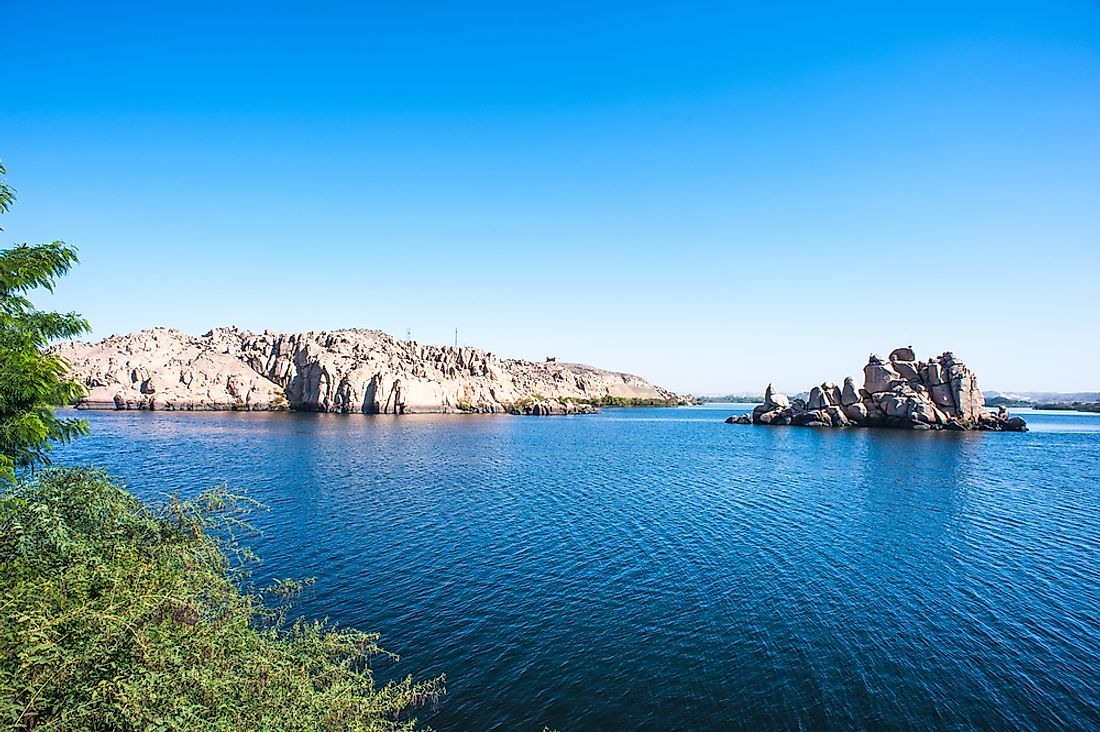Interesting Facts Related To Lake Nasser In Egypt

Where Is Lake Nasser Located?
Lake Nasser is one of the world’s biggest artificial lakes and its waters are shared by the two neighboring countries of Egypt and Sudan. The lake occupies parts of southern or Upper Egypt and northern Sudan. A section of the water body is referred to as Lake Nubia by the Sudanese to commemorate the Nubian homeland that was submerged under the waters during the formation of Lake Nasser.
Dimensions Of Lake Nasser
Lake Nasser has a length of 479 km and a maximum width of 16 km. The maximum depth of the lake is 590 ft while the average depth is 83 ft. The total area encompassed by the lake is 5,250 square km. Lake Nasser can store water of about 132 cubic km.
Construction And Naming Of Lake Nasser
The Aswan High Dam was a mega-project launched by the Egyptian government to construct a massive dam on the Nile river to generate hydroelectric power and also to reduce the frequency and strength of the floods downstream of the river. Prior to the construction of the dam, seasonal floods would cause great damage to Egyptian farmlands further downstream.
The Aswan High Dam was thus constructed between 1958 and 1970. Lake Nasser was created as a consequence of the creation of the dam. The river’s waters flooded vast areas beyond the dam resulting in the formation of Lake Nasser.
The lake is named after Gamal Abdel Nasser, the Egyptian President who initiated the Aswan High Dam project. He was also one of the leading figures of the 1952 Egyptian Revolution.
Nubian Homeland Lost Under Lake Nasser
The area that is now filled with the waters of Lake Nasser was previously part of Nubia, the homeland of the Nubian people of Sudan and Egypt. The Nubians are a 7000-year strong civilization who owned land along the Nile in Nubia where they practiced agriculture, fishing, cattle-raising, and other activities. The region also hosted large monuments and temples dating back to ancient Egypt. The construction of the Aswan High Dam thus flooded large parts of Nubia and submerged the land of these people and monuments of great historical importance under the newly created lake. Thousands of Nubian families had to be displaced and the UNESCO helped the engineers, historians, and archeologists relocated several monuments to higher grounds. The Abu Simbel temples are one of the finest examples of such relocation. The Nubian people of Egypt still complain about their displacement since many of them are now forced to live away from the Nile that earlier served as the lifeline of these people.
Addressing Future Issues
Ethiopia is presently constructing a dam on the Blue Nile River, one of the Nile river’s main tributaries. The dam, named the Grand Ethiopian Renaissance Dam, is now nearly 60% complete. There is fear in Egypt that once this dam is completed, the Nile river reaching Egypt will receive less water than what it does now. Thus, although the Sudanese and Ethiopians will reap benefits from the projects, Egypt might suffer from water shortage in Lake Nasser. This scenario will affect the hydroelectric power generation capacity of the Aswan High Dam’s power station. It will also mean less water is available for irrigation in the Lake Nasser area.
Fishing And Tourism Associated With Lake Nasser
The rippling blue waters of Lake Nasser and the desert scenery along its banks is a beautiful sight. Several tourist and recreational activities are based in and around Lake Nasser. Fishing is allowed in parts of the lake and people can enjoy fishing both from the shore and from the boats. Fishing in Lake Nasser is also an important activity of the people living along the lake. Nile perch is a prized catch for the anglers here. Besides fishing, one can enjoy a cruise on the lake. Some temples and monuments of ancient Egypt can be viewed while taking the cruise on the lake. The Abu Simbel temple is a famous temple of the ancient times that is located near the shores of Lake Nasser. Other famous monuments along the Lake Nasser include the Philae Temple, Kalabsha Temple, the Qasr Ibrim archeological site, and others. The floor of the lake is a treasure trove of ancient monuments that were submerged by the waters of the lake during its creation.
The Nile Crocodile Thrives In Lake Nasser
The Nile crocodile that is considered to be one of the most aggressive species of crocodiles surviving today can be found in the Lake Nasser. In fact, the lake is one of the last safe havens of this species which is fast vanishing, partly due to the destruction of habitat by the creation of dams and also due to rampant poaching activities. If one is lucky, the crocodiles can be seen basking in the sun along the shores of Lake Nasser.











